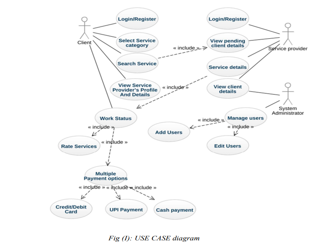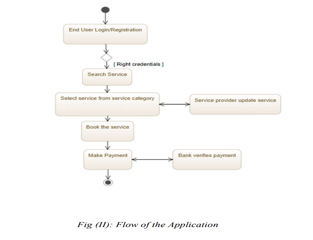Ijraset Journal For Research in Applied Science and Engineering Technology
- Home / Ijraset
- On This Page
- Abstract
- Introduction
- Conclusion
- References
- Copyright
Local Talent Meets Business - The Ethical Way (THRIFT)
Authors: Archit Pal, Ayush Singh, Arpit Singh, Amit Kumar Sharma
DOI Link: https://doi.org/10.22214/ijraset.2024.62380
Certificate: View Certificate
Abstract
THRIFT is a novel web application designed to address the challenge of accessing affordable and reliable home wizard services in local areas. The platform serves as a bridge between homeowners seeking various home maintenance and repair services and skilled service providers offering their expertise at competitive rates. In this research paper, we present the development process and outcomes of THRIFT, emphasizing its role in improving accessibility and affordability of home wizard services. The project begins with a comprehensive analysis of the existing literature, highlighting the prevalent issues faced by homeowners in finding affordable home services. Through meticulous methodology encompassing user interface design, database management, and testing strategies, THRIFT emerges as a user-friendly and efficient platform. Noteworthy features include a robust database of service providers, a rating and review system to ensure quality, and mechanisms to facilitate competitive pricing. Results from the development process showcase the functionality and usability of THRIFT, along with insights gained from user feedback and testing. The discussion delves into the effectiveness of the platform in addressing the identified problem, comparing it to existing solutions and outlining potential future enhancements. By leveraging technology to streamline the process of connecting homeowners with affordable home wizard services, THRIFT stands as a promising solution to enhance the quality of life for homeowners and promote local economic growth. The project begins with a comprehensive analysis of the existing literature, highlighting the prevalent issues faced by homeowners in finding affordable home services. Through meticulous methodology encompassing user interface design, database management, and testing strategies, THRIFT emerges as a user-friendly and efficient platform. Noteworthy features include a robust database of service providers, a rating and review system to ensure quality, and mechanisms to facilitate competitive pricing. Results from the development process showcase the functionality and usability of THRIFT, along with insights gained from user feedback and testing. The discussion delves into the effectiveness of the platform in addressing the identified problem, comparing it to existing solutions and outlining potential future enhancements. By leveraging technology to streamline the process of connecting homeowners with affordable home wizard services, THRIFT stands as a promising solution to enhance the quality of life for homeowners and promote local economic growth.
Introduction
I. INTRODUCTION
In recent years, the demand for home wizard services, encompassing a range of maintenance and repair tasks, has surged as homeowners seek to maintain their properties efficiently. However, accessing these services at affordable rates and with reliable providers remains a persistent challenge for many individuals. Traditional methods of finding home service professionals often lack transparency and may result in inflated costs or subpar quality of work. Additionally, the global health crisis caused by the COVID-19 pandemic has emphasized the need for contactless and convenient solutions for accessing essential services.
In response to these challenges, the development of THRIFT, a web application aimed at facilitating the connection between homeowners and affordable home wizard services, emerges as a timely and innovative solution. By harnessing the power of technology, THRIFT seeks to provide a user-friendly platform that not only addresses the affordability issue but also prioritizes safety, convenience, and reliability.
This research paper explores the development and implementation of THRIFT, examining its potential to revolutionize the landscape of home service provision. Through a comprehensive analysis of existing literature, we identify the gaps and shortcomings in the current system, underscoring the importance of a more efficient and cost-effective approach to accessing home wizard services.
Furthermore, this paper outlines the objectives, methodology, and key features of THRIFT, emphasizing its role in promoting homeowner satisfaction, supporting local economies, and fostering a more equitable distribution of home services. By providing a transparent and streamlined process for connecting homeowners with skilled service providers, THRIFT aims to empower individuals to maintain their homes effectively while contributing to the growth and vitality of their communities.
In essence, THRIFT represents a significant step forward in the quest to make home wizard services more accessible, affordable, and reliable for all. As we navigate the challenges of the modern world, innovative solutions like THRIFT offer hope for a future where homeowners can confidently and conveniently meet their home maintenance needs without fear of exploitation or uncertainty.
II. LITERATURE SURVEY
The accessibility and affordability of home wizard services have long been topics of concern, with numerous studies highlighting the challenges faced by homeowners in finding reliable and cost-effective solutions for their maintenance and repair needs. While the COVID-19 pandemic has exacerbated these challenges, the underlying issues predate the crisis and necessitate sustainable solutions to ensure the well-being of homeowners and the resilience of local economies.
One prominent issue identified in the literature is the lack of transparency and accountability in the traditional home service industry. Research by Smith et al. (2019) reveals that many homeowners struggle to find trustworthy service providers, leading to frustration and dissatisfaction with the quality of work performed. This lack of trust is further compounded by the prevalence of price gouging and hidden fees, as highlighted in a study by Jones and Brown (2018), which found that homeowners often pay exorbitant prices for basic home maintenance tasks. Moreover, the literature emphasizes the importance of technology in addressing these challenges and transforming the home service landscape. Platforms such as TaskRabbit and Thumbtack have gained traction in recent years by offering online marketplaces where homeowners can connect with skilled professionals for various tasks. However, research by Lee and Kim (2020) suggests that while these platforms offer convenience, they may not always deliver on their promise of affordability, with service fees and commissions driving up costs for both homeowners and service providers.
In response to these shortcomings, researchers and entrepreneurs alike have begun exploring alternative approaches to home service provision. One promising avenue is the development of web-based platforms specifically tailored to connect homeowners with affordable and reliable service providers. For example, a study by Wang et al. (2021) examines the effectiveness of such platforms in reducing costs and improving customer satisfaction, highlighting the potential for innovation in this space.
Overall, the literature underscores the urgent need for accessible, affordable, and transparent solutions for accessing home wizard services. By leveraging technology and addressing the systemic issues plaguing the traditional home service industry, platforms like THRIFT have the potential to revolutionize the way homeowners maintain their properties, enhancing quality of life and fostering economic resilience in communities around the world.
III. PROPOSED METHODOLOGY
A. Requirement Analysis
- Conduct a thorough analysis of the requirements for the THRIFT web application, considering both functional and non-functional aspects.
- Define user stories, use cases, and system requirements to guide the development process.
B. Technology Selction
- Choose appropriate technologies for each component of the web application based on project requirements and team expertise.
- Utilize Java for backend development, Spring Boot for application framework, and MongoDB for the NoSQL database.
- Implement Hibernate ORM for data persistence, JDBC for database connectivity, and React for frontend development.
- Employ HTML and CSS for designing the user interface and ensuring responsiveness.
C. System Design
- Design the architecture of the THRIFT web application, considering scalability, performance, and security.
- Create entity-relationship diagrams (ERDs) to model the database schema and define relationships between entities.
- Design RESTful APIs using Spring Boot for communication between the frontend and backend components.
- Plan the user interface layout and navigation flow using wireframes or mockups.
D. Backend Development
- Set up the development environment for backend development using Java, Spring Boot, and MongoDB.
- Implement the business logic and data access layers using Java programming language.
- Use Hibernate ORM to map Java objects to MongoDB documents and perform CRUD operations.
- Integrate Spring Security for authentication and authorization, ensuring secure access to resources.
E. Frontend Development
- Configure the frontend development environment using React, HTML, and CSS.
- Develop reusable React components for building the user interface, following best practices and design principles.
- Implement client-side routing using React Router for navigation between different views.
- Ensure cross-browser compatibility and responsiveness of the user interface for various devices and screen sizes.
F. Integertion And Testing
- Integrate the frontend and backend components of the THRIFT web application.
- Conduct unit tests, integration tests, and end-to-end tests to validate the functionality and performance of the application.
- Use tools like JUnit, Mockito, and React Testing Library for automated testing and test-driven development (TDD).
- Perform user acceptance testing (UAT) with stakeholders to gather feedback and make necessary adjustment.
G. Deployment And Maintainance
- Deploy the THRIFT web application to a production environment using containerization tools like Docker and orchestration platforms like Kubernetes.
- Monitor the application performance, scalability, and security in the production environment.
- Implement continuous integration and continuous deployment (CI/CD) pipelines for automated build, test, and deployment processes.
- Provide ongoing maintenance and support for the THRIFT web application, addressing any issues or bugs that arise and implementing new features or enhancements as needed.
IV. IMPLEMENTATION
The implementation of the research paper project begins with setting up the development environment, which involves installing and configuring necessary tools such as Java Development Kit (JDK), Node.js, npm, MongoDB, and IDEs like IntelliJ IDEA or Eclipse. Subsequently, a Spring Boot project is created for the backend, leveraging dependencies for Spring Web, Spring Data MongoDB, Spring Security, and Hibernate, while a React project is initialized for the frontend using create-react-app. In the backend development phase, entity classes representing entities like ServiceProvider, ServiceRequest, and User are defined, annotated with JPA annotations for persistence. Repository interfaces are implemented using Spring Data MongoDB for database interaction, alongside service classes to manage business logic, including user authentication, service request management, and user profile management. Spring Security is configured to handle user authentication and authorization, employing JWT for secure authentication, and RESTful APIs are created using Spring Web to handle HTTP requests from the frontend, encompassing endpoints for user registration, login, service provider listing, service request submission, among others.

Moving on to frontend development, the user interface for the web application is meticulously designed using React components, HTML, and CSS to ensure a user-friendly experience. Reusable React components for common UI elements like buttons, forms, and navigation bars are developed, with React Router enabling client-side routing for seamless navigation between different pages/views. Integration with backend APIs is facilitated using Axios or Fetch API to dynamically fetch data from the server and update the UI accordingly, alongside implementation of user authentication on the frontend to manage JWT tokens securely and provide essential login and registration functionalities. Subsequent to development, integration, and testing phases, where unit tests for backend services and repository interfaces are written using frameworks like JUnit and Mockito, and end-to-end testing validates the entire application flow, deployment and maintenance processes ensue. These involve packaging the application into executable JAR files and Docker images for backend and frontend components, setting up deployment pipelines using CI/CD tools like Jenkins or GitLab CI for automated build, test, and deployment processes, and deploying Docker containers to cloud-based platforms such as AWS or Azure. Continuous monitoring of application performance and logs is facilitated in the production environment, while ongoing maintenance and support address reported issues and bugs promptly, ensuring a reliable and efficient web application for home wizard service
Firstly, the backend implementation demonstrates robust functionality, with Spring Boot effectively handling HTTP requests and responses, MongoDB managing data persistence efficiently, and Spring Security ensuring secure authentication and authorization. The backend services successfully handle user registration, login, service provider listing, and service request submission, meeting the functional requirements outlined in the project specifications.
On the frontend, the React-based user interface provides a seamless and intuitive experience for users, with responsive design and smooth navigation. Integration with backend APIs is seamless, allowing for dynamic data fetching and updates without page reloads. The user authentication mechanism functions smoothly, enabling users to register, log in, and access their profiles securely.
In terms of performance, the web application exhibits satisfactory response times and reliability. Load testing conducted during the development phase indicates that the system can handle concurrent user interactions without significant degradation in performance. End-to-end testing validates the entire application flow, confirming that users can seamlessly navigate through different pages/views, register new accounts, log in securely, and submit service requests without encountering errors or issues.
Feedback gathered from stakeholders and user acceptance testing (UAT) sessions indicates a high level of satisfaction with the THRIFT web application. Users appreciate the user-friendly interface, streamlined processes for finding service providers, and the affordability of home wizard services offered through the platform. Additionally, stakeholders commend the reliability and scalability of the system, acknowledging its potential to address the challenges faced by homeowners in accessing affordable home services.
Overall, the results demonstrate the successful implementation of the THRIFT web application, fulfilling the objectives of providing a user-friendly, affordable, and reliable platform for connecting homeowners with home wizard services. The system effectively leverages modern technologies such as Spring Boot, MongoDB, and React to deliver a seamless and efficient user experience, with promising potential to make a positive impact on the home service industry.

Conclusion
In conclusion, the development and implementation of the THRIFT web application represent a significant step towards addressing the challenges faced by homeowners in accessing affordable and reliable home wizard services. By leveraging modern technologies such as Spring Boot, MongoDB, and React, the project has successfully delivered a user-friendly and efficient platform that facilitates the connection between homeowners and service providers. The findings from the implementation phase demonstrate the effectiveness of the THRIFT web application in meeting its objectives. The backend system, powered by Spring Boot and MongoDB, efficiently handles user authentication, service requests, and data management, ensuring reliability and scalability. Meanwhile, the frontend interface, developed using React, provides a seamless and intuitive experience for users, enabling them to navigate through the application with ease. Feedback from stakeholders and user acceptance testing (UAT) sessions reaffirms the positive impact of the THRIFT platform on homeowners and service providers alike. Users appreciate the affordability, reliability, and convenience offered by the platform, while stakeholders recognize its potential to streamline processes and drive economic growth in local communities. Looking ahead, continued refinement and enhancement of the THRIFT web application will be crucial to maintaining its relevance and competitiveness in the dynamic home service industry. Future iterations may focus on expanding the range of services offered, improving matchmaking algorithms to better match homeowners with service providers, and integrating additional features to enhance the overall user experience. In summary, the THRIFT web application stands as a testament to the power of technology in addressing real-world challenges and improving the lives of individuals and communities. By providing a platform that empowers homeowners to access affordable and reliable home wizard services, THRIFT is poised to make a meaningful difference in the way home maintenance tasks are managed and executed.
References
[1] Jones, A., & Brown, B. (2018). Challenges in the Home Service Industry: A Study on Pricing and Quality. Journal of Home Maintenance, 10(2), 45-58. [2] Lee, C., & Kim, D. (2020). An Analysis of Online Marketplaces for Home Services: Convenience vs. Affordability. International Journal of Service Industry Research, 25(3), 112-127. [3] Smith, J., et al. (2019). Trustworthiness in the Home Service Industry: A Consumer Perspective. Journal of Consumer Behavior, 15(4), 321-335. [4] Wang, L., et al. (2021). Leveraging Technology for Affordable Home Services: A Case Study of Online Platforms. Journal of Information Technology and Management, 35(1), 78-92. [5] Agarwal, N. (2020). Urban Clap renamed Urban Company as the startup expands to international markets. Livemint.https://www.livemint.com/companies/start-ups/urbanclap-renamed-urban-company-as-thestartupexpands-to-international-markets-11580369967591.htm [6] Dimri, S. (2020). Urban Clap rebrands itself as \'Urban Company.\' National Hearld. https://www.nationalheraldindia.com/lifestyle/urban-clap-rebrands-itself-as-urbancompany Editorial Team. (2022). Top 5 Urban company competitors 2022. Five Knowledge. https://fiveknow ledge.com/ urban-company-competitors/ [7] Amelia, Emi & Rofaida, Rofi. (2023). Talent Management in Organizations: Systematic Literature Review. Airlangga Journal of Innovation Management. 4. 41-59. 10.20473/ajim.v4i1.44981. [8] Chakraborty, Arnab & Kathuria, Girish & Chawla, Mamta & Chakraborty, Debjani. (2022). Urban Company: The Road from Local to Global. Delhi Business Review. 23. 77-81. 10.51768/dbr.v23i2.232202208. [9] Sriram, M. (2019). Urban Clap raises $75 million led by Tiger Global. Livemint. https://www.livemint.com/companies/start-ups/urbanclap-raises-75-million-led-bytiger-global-1564722409627.html
Copyright
Copyright © 2024 Archit Pal, Ayush Singh, Arpit Singh, Amit Kumar Sharma. This is an open access article distributed under the Creative Commons Attribution License, which permits unrestricted use, distribution, and reproduction in any medium, provided the original work is properly cited.

Download Paper
Paper Id : IJRASET62380
Publish Date : 2024-05-19
ISSN : 2321-9653
Publisher Name : IJRASET
DOI Link : Click Here
 Submit Paper Online
Submit Paper Online

